Is Complying with the Complex Patchwork of PFA Regulations A Concern for Your Company?
Per- and polyfluoroalkyl substances, known as PFAs, are a family of more than 9,000 widely used, man-made chemicals found in industrial and consumer products, worldwide, for over 70 years.1 They are known as Forever Chemicals because they break down very slowly in the environment over time.2 Among the family of PFAs are perfluorooctanoic acid (PFOA), perfluorooctanesulfonic acid (PFOS), and Hexafluoropropylene Oxide Dimer Acid (also known as “GenX”).3 Uses of PFAs include stain-resistant textiles, food-handling materials, firefighting foam, medical devices, paints, personal care products, construction materials, and industrial processing aids. Research suggests exposure to some PFAs might result in harmful health outcomes, including some cancers, hyperlipidemia, reduced birth weight, and disorders of the immune system.4,5
Community exposure to PFAs may occur through drinking water, air, soil, food, or consumer products. PFAs may enter the environment from waste streams such as PFAs-contaminated sewage sludge and septage applied to farmland and leachate from unlined landfills, through direct releases of specific PFAs-containing products (e.g., some firefighting foams), and by other ways that are under investigation.6
The presence of PFAs in the soil, water, or air can lead to uptake by plants and animals raised for consumption, resulting in contaminated foods. PFAs have been shown to migrate from food wrappers into food.4 Results of the Food and Drug Administration’s (FDA) Total Diet Study (TDS) tests of a variety of foods showed that overall, PFAs were found in few samples, and where they were found, low levels were detected.7 The FDA performed targeted seafood testing in 2022 and found more types of PFAs and higher levels compared with the TDS food samples. PFAs have been found in samples of blood and breastmilk around the world.2
There are no federal standards for any PFAs compounds. Groundwater health advisory levels for two of the most studied PFAs — PFOA and PFOS were promulgated by the Environmental Protection Agency (EPA).8 EPA added five PFAs to a list of risk-based values for site cleanups known as Regional Screening Levels and Regional Remedial Management Levels, in May 2022. Those levels guide EPA’s determination of the need for response or remediation activities.9 The real problem is the patchwork of different toxicity based cleanup levels (ground water levels can be in parts per trillion) that have been developed by states due to the perceived inaction by EPA.
QTS Group is expert at delivering PFA exposure sampling, monitoring, analysis and remediation planning services for our construction clients to ensure safe operations and regulatory compliance. Let us know how we can assist your company.

